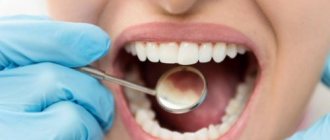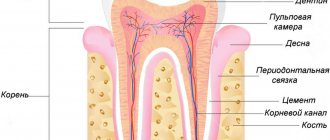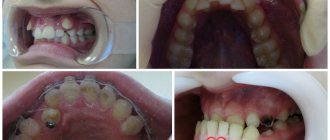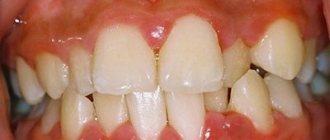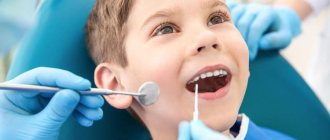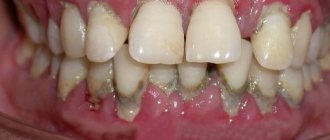Author of the article:
Soldatova Lyudmila Nikolaevna
Candidate of Medical Sciences, Professor of the Department of Clinical Dentistry of the St. Petersburg Medical and Social Institute, Chief Physician of the Alfa-Dent Dental Clinic, St. Petersburg
Caries is a disease that affects all people, regardless of their gender, age and place of residence. Caries is caused by bacteria that settle in the oral cavity due to poor nutrition and poor oral hygiene.
Modern treatment of caries
Thanks to the constant improvement of techniques, today the diagnosis and treatment of dental caries is carried out at a high level, which allows for maximum preservation of healthy tissue. In addition, in situations where just a few years ago advanced caries led to mandatory tooth extraction, today tooth-preserving operations are performed. Among them are the following.
- Resection:
treatment of tooth root caries by removing the apex of the root. - Root amputation:
removal of the damaged root part of a two-rooted or three-rooted tooth. - Coronoradicular separation:
separation of tooth roots. It is carried out when caries has affected the tooth in the area of root branching. - Hemisection:
removal of the damaged part of a multi-rooted tooth and the adjacent crown area.
Causes of caries
Most often, the appearance of caries is caused by inappropriate oral hygiene and an unbalanced diet - abuse of fatty, salty and too acidic foods, which leads to the destruction of the enamel layer. Among other provocateurs of carious lesions:
- deficiency of vitamins in the body (calcium, vitamin A, C, etc.);
- unfavorable environmental conditions (poor quality of drinking water);
- disturbances in the functioning of the gastrointestinal tract;
- genetic predisposition;
- disruption of the salivary glands;
- taking certain medications.
Concomitant serious diseases, for example, tuberculosis and other pathologies that undermine the immune system, also lead to the appearance of signs of caries.
Indications for the treatment of dental caries
Indications are reduced to visual and tactile.
✔
Visual:
stains on the enamel, darkening of the cervical area of the tooth, chipping of part of the tooth and darkening underneath it, a dark border around the perimeter of the filling, a carious hole.
✔
Tactile:
aching pain when eating sweet, salty and sour foods, and acute pain from sudden temperature changes.
Types of caries by localization
fissure
It begins in the physiological recesses of the chewing teeth - fissures. The patient cannot detect it during self-examination.
Approximal (or contact)
It begins on the contacting surfaces of adjacent teeth. As a rule, this is a consequence of not using floss or irrigator as part of hygiene.
Cervical
It begins at the base of the gum, gradually destroying the neck of the tooth. It is the result of severe tartar.
Interior
It begins under the tooth filling if errors were made during its installation.
Under the crown
It begins under the crown if it does not fit tightly to the tooth, causing microscopic food debris to accumulate.
Caries in adults
Caries in adults develops quite slowly. Most patients seek help from a dentist at the stage of medium and deep caries. After a detailed diagnosis, the doctor most often resorts to the traditional method of treatment; in case of deep tissue damage against the background of complicated caries (pulpitis), endodontic therapy cannot be avoided.
Types of caries according to severity
Initial caries
Characterized by a change in the color of the enamel: the so-called white spot caries. Does not cause discomfort to the patient.
Superficial caries
Characterized by the appearance of dark spots on the enamel. The affected tooth may react weakly to cold, sour or sweet foods for a short time.
Average caries
Characterized by destruction of dentin. Painful sensations to external stimuli are more pronounced and last longer.
Deep caries
Characterized by damage to a large area of tooth enamel and dentin. The pain does not go away without the use of analgesics.
Laser preparation
With this method, the dentist uses pulsed lasers specially designed for dental treatment. The device consists of three basic elements - the main block, which produces radiation of a specific frequency and power, as well as a light guide and a tip. It is with the help of the tip that the dentist performs manipulations in the patient’s oral cavity. The tips come in different shapes, but all have a cooling system.
The process of laser tooth preparation is carried out in this way. The base unit produces laser beams. Getting on the hard tissues of the teeth, they heat the moisture contained in them. Something like an explosion occurs, which leads to microscopic destruction in the tooth enamel and dentin. At the same time, nearby tissues heat up slightly. Then, using a spray of water and air, particles of dental tissue are removed from the oral cavity. What is the advantage of laser preparation compared to mechanical preparation? In the first case, there is no irritation of nerve endings and strong heating of hard tissues, so the laser procedure is painless and does not require anesthesia. Also, laser treatment of the cavity is more controlled and faster, and the surface of the carious cavity after laser treatment does not require additional etching.
After preparation, the dentist treats the carious cavity with medication and installs a filling. In some cases, after filling it is necessary to additionally remineralize the tooth.
Modern methods of treating dental caries
Today, there are several methods for treating caries, differing in the degree of surgical intervention - the earlier the degree of development of the disease, the greater the likelihood that it will be possible to get rid of it with few sacrifices.
Modern technologies for treating caries without preparation:
- Remineralization:
a procedure for treating enamel caries, which involves treating the tooth surface with a solution containing fluoride, phosphorus and calcium. The patient is also prescribed a number of medications to take orally. Helps in the treatment of white caries, or caries in the spot stage. - Infiltration:
chemical-mechanical treatment is also a method of treating caries without preparing Icon. It is used for initial caries and only on smooth surfaces or between teeth. First, a gel is applied to the carious area, which splits the affected enamel; the site of bacterial development is dried under the influence of ethyl alcohol and an air stream and treated with a polymer resin, which fills the enamel pores. The entire procedure lasts about fifteen minutes. - Air abrasive treatment:
“knocking out” superficial caries using a powerful stream of abrasive particles. The force of action is designed to affect only soft tissues affected by bacteria. The method is painless, and therefore there is no need for anesthesia. Air abrasive treatment reduces the risk of microcracks forming after treatment, in some cases it is even more effective than a drill. However, this method of caries treatment is not always applicable. - Ozone treatment:
destruction of caries bacteria using a natural antibiotic and oxidizing agent - ozone. Another method of non-contact treatment of caries. Ozone not only suppresses infection, but also has a remineralizing effect on tissue. During the procedure, a special device converts ozone from oxygen and supplies it to the affected area. Ozone destroys bacteria and is converted back into oxygen. The technology for treating caries with ozone allows you to leave healthy cells intact. Another advantage is that there is no need for anesthesia. The treatment time for caries using this method is less than a minute. Like the previous one, it is suitable only in the initial stages of caries or as its prevention. - ART technique:
restorative therapy, during which, using a special instrument, the affected tissue is removed and the cavity is filled with special dental cement. This method of treating caries was invented in third world countries, where it was not possible to open full-fledged dental offices, but it is also used in developed countries. Completely manual work allows you to act carefully and preserve as much healthy tissue as possible. - Laser treatment:
an effective technique for eliminating superficial and intermediate caries (for example, in the treatment of dentin caries) using laser fluorescence. During the procedure, a bactericidal solution is used, which cools the tooth and reduces pain. In addition, laser devices do not produce vibrations, which could increase pain. That is why the laser treatment method is indicated primarily for children and pregnant women. The laser selectively acts on the affected area, “evaporating” it, and disinfects the resulting cavity, thus eliminating the risk of developing secondary caries. - Treatment of dental caries with diet:
a method of treating caries naturally, developed based on the scientific theory of the American researcher Ramiel Nagel. According to his observations, caries does not have an infectious-bactericidal nature, but is associated with the weakening and destruction of enamel due to a lack of necessary substances. Therefore, the problem can be solved with proper nutrition. Adherents of natural treatment recommend actively using cod liver, fish caviar, butter and other products containing fat-soluble vitamins, nutritious broths, as well as chicken, beef and fish. It is better not to overuse fruits - due to their high sugar content - and combine them with small portions of fat, such as cream.
Why can't you try to get rid of caries yourself?
Only a dentist knows how to treat caries. Under no circumstances should you try to get rid of it yourself. Unfortunately, there are often cases when patients come to the dental clinic who tried to scrape off caries themselves and thereby only worsened the condition of their oral cavity.
Among these “barbaric” methods:
- removing carious stains or tartar using a file or sandpaper, which will cause severe damage to the enamel and will only accelerate the development of caries;
- cleaning the carious area with a needle: even if it is possible to remove the darkened area in this way, this will not stop the process of tooth decay;
- whitening dark carious spots using bleach or other bleaches: this can not only damage the tooth, but also cause a burn to the mucous membrane;
- whitening with vinegar: you can not only worsen the condition of damaged enamel, but also burn your gums and the inside of your cheeks.
Classical treatment of caries in permanent teeth
In advanced cases, non-invasive treatment methods for caries will not help, so specialists turn to the old but effective removal of caries using drilling.
The procedure involves cleaning the affected canals using a drill; if dentin is damaged, pulp and infected tooth tissue can also be removed. It should be noted that the devices that are used for this today have gone far ahead of those that once brought fear to our grandparents. Anesthesia and disinfectants can reduce the pain effect and make the procedure more comfortable for the patient. To complete the treatment of caries, a filling or crown is placed on the tooth and adjusted so that the patient does not feel any discomfort.
Caries: features, symptoms
According to statistics, at least 95% of people in the world have encountered caries at least once. This is the most common dental disease that affects people regardless of gender, age and lifestyle.
Caries belongs to the list of pathological processes. Initially, it begins to destroy the enamel, but if left untreated, it also affects the deep hard layers of tooth tissue. When soft tissue inflammation begins, blood vessels and nerves are inevitably also affected.
Patients often wonder whether tooth decay needs to be treated. In fact, it is necessary not only to engage in prevention, but also to begin treatment as soon as possible. If the disease is neglected, there is a high risk of losing the tooth completely.
Main stages of the procedure
If for caries in the stain stage, treatment comes down to brushing the teeth with a special brush, applying a remineralizing composition and taking medications to strengthen the enamel, then in later stages it is necessary to remove the affected tissue and fill the cavity. In this scenario, the principle of caries treatment is as follows:
- anesthesia;
- preparation of a carious cavity;
- removal of infected tissue;
- cavity treatment;
- tooth filling.
Caries treatment and filling are carried out in one appointment. If, during the treatment of caries, damage to the dental pulp is detected, it may require its removal.
Mechanical and chemical-mechanical preparation
With the mechanical method, the carious cavity is prepared using hand instruments and dental burs. This option is the most common.
During chemical-mechanical preparation, the dentist first acts on the affected dental tissues with special solutions and gels that destroy the areas affected by caries. And then, using hand instruments, he cleans the cavity and fills it.
There is also an ART technique developed in Russia, in which the affected tissue is first removed with a hand instrument, then gels with different effects are applied one by one. The treatment is completed by re-cleaning the cavity using instruments and rinsing with water.
Choosing a filling
Previously, mainly mineral cements, acrylic and epoxy, and amalgams were used to make fillings. Today, outdated fillings, which were imperfect in terms of fixation and aesthetics, have been replaced by modern inlays. They improve the adhesion strength to the tooth surface, do not require labor-intensive installation, and are biocompatible with the human body. Among them, the most used are: composites, glass ionomer cements, ormocers, compomers. Materials can be combined to achieve the desired effect.
Air-abrasive method of preparation
Essentially, this is sandblasting the hard tissues of a diseased tooth. Through a special tip, an aerosol containing water and an abrasive substance is applied to the surface of the tooth. This method is used before sealing fissures or to remove pigmented areas of tooth enamel.
The air abrasive method can be used to prepare small carious cavities. The advantages of this method are minimal tissue excision and the creation of a rough surface that does not require additional acid etching.
Is it possible to cure tooth decay at home?
Treatment of dental caries at home is impossible. However, this disease is preventable. To do this, you should regularly perform oral hygiene using calcium and fluoride toothpaste, visit the dentist twice a year and ensure that your diet contains enough proteins and fewer carbohydrates. For additional protection, you can apply gels to strengthen tooth enamel, which will saturate the teeth with minerals - they are not a cure for caries, but will help reduce the risk of developing the disease.
If it is too late to prevent caries, then herbal compresses and rinsing with strong tea will help temporarily reduce the intensity of pain. You can also press on the area between the lips and nose - there is a point there, the impact of which will send signals to the brain that distract it from the main source of pain. However, instead of diligently practicing traditional healing, it is better to turn to a professional as soon as possible. After all, only he will help you effectively cope with the problem.
Why is it necessary to treat caries?
If you ignore the first symptoms of the disease and do not consult a dentist, then caries will continue its destructive effect and eventually reach the pulp of the tooth. After this, more serious treatment will be required, including removal of nerves and filling of canals. If you continue to ignore caries, you will not only have to endure toothache from time to time, but also prepare for the fact that in a couple of years you will lose your tooth forever. Keep in mind: a tooth that is filled in several places will last longer than a tooth that gradually decays. In addition, if the root remains alive, then it will be possible to put a crown on it, which is preferable to a denture.
You also need to monitor your health after the tooth is healed. If you feel discomfort in the area of the healed tooth under the filling, then it is quite possible that a gap has formed there where food can penetrate. As a result, caries may develop under the filling. After assessing the situation, the dentist may suggest removing the old filling, re-cleaning the cavity and installing a new one.
Cost of caries treatment in Moscow
The cost of caries treatment in each specific case is calculated individually and consists of several components:
- what type of filling will be installed;
- what type of anesthesia will be used;
- how much work the doctor has to do.
Thus, installing a filling on a chewing tooth affected by caries in state dentistry can cost 900 rubles, since it involves the cheapest composite material. The cost of a light filling in a private dental clinic in Moscow varies between 1500 – 2500 rubles. Treatment of caries of anterior teeth exceeds 3,000 rubles, since there are increased demands on aesthetics. As for anesthesia, local anesthesia starts at 300 rubles per tooth, general anesthesia starts at 2,000 rubles, and treatment with sedation, depending on its degree, ranges from 3,000 to 15,000 rubles.
Is it possible to treat teeth for pregnant women?
Many patients are interested in whether caries can be treated during pregnancy. There is a common misconception that using anesthesia is dangerous and poses a great risk to the health of both mother and child.
In fact, a lot of this depends on the state of the woman. In the later stages, it is best to avoid treatment, because severe stress can negatively affect the woman’s condition.
Otherwise, it is much better to cure your teeth than to put up with the potential consequences. For a woman, the consequences of untreated caries will be much more dangerous - a strong inflammatory process in the body, the potential introduction of infection into the blood.
